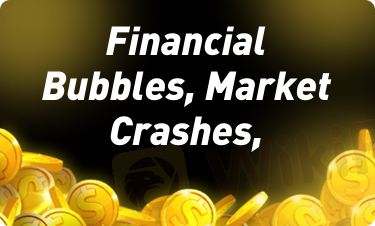
2025-02-17 18:19
IndustriyaFinancial Market Bubbles and Crashes
#firstdealofthenewyearastylz
Financial Market Bubbles and Crashes
A financial market bubble occurs when asset prices rise significantly above their intrinsic value due to excessive speculation, investor overconfidence, and herd behavior. Eventually, when the overvaluation is no longer sustainable, the bubble bursts, leading to a market crash—a rapid and often severe decline in asset prices.
Causes of Financial Bubbles
1. Excess Liquidity – Low interest rates and easy access to credit can inflate asset prices.
2. Speculation & Herd Mentality – Investors buy assets purely based on rising prices, not fundamentals.
3. Overconfidence & Irrational Exuberance – Investors ignore risks and believe prices will keep rising.
4. Leverage & Margin Trading – Borrowing money to invest amplifies gains but also magnifies losses.
5. Technological or Economic Innovations – New industries (e.g., dot-com boom) attract speculative investments.
Notable Financial Bubbles in History
1. Tulip Mania (1630s, Netherlands) – Tulip bulbs were traded at absurd prices before crashing.
2. South Sea Bubble (1720, UK) – Stock prices of the South Sea Company surged due to speculation and collapsed.
3. 1929 Stock Market Crash – Excessive speculation in stocks led to the Great Depression.
4. Dot-Com Bubble (1999-2000) – Internet company stocks soared irrationally before collapsing.
5. 2008 Financial Crisis – A housing bubble fueled by subprime mortgages burst, leading to a global recession.
Market Crashes: Causes & Effects
A market crash is triggered when investor confidence collapses, leading to panic selling. This can result from:
Economic shocks (e.g., financial crises, wars, pandemics)
Policy changes (e.g., interest rate hikes)
Corporate failures (e.g., Lehman Brothers in 2008)
Effects of a Market Crash:
Wealth Destruction – Investors and businesses lose significant value.
Bank Failures – If financial institutions are exposed, they may collapse.
Unemployment – Economic downturns often follow, leading to job losses.
Government Interventions – Bailouts, stimulus packages, and policy changes may be necessary.
Lessons from Market Bubbles & Crashes
Diversification reduces risk.
Avoid speculation and excessive leverage.
Understand fundamental value rather than following hype.
Monitor interest rates and economic indicators.
Be prepared for market corrections; they are inevitable.
Katulad 0

Ojomary
Mga brokers
Mainit na nilalaman
Pagsusuri ng merkado
Dogecoin cheers coinbase listing as Bitcoin’s range play continues
Pagsusuri ng merkado
Grayscale commits to converting GBTC into Bitcoin ETF:
Pagsusuri ng merkado
Bitcoin's price is not the only number going up
Pagsusuri ng merkado
Theta Price Prediction:
Pagsusuri ng merkado
How to Research Stocks:
Pagsusuri ng merkado
Bitcoin (BTC), Ethereum (ETH) Forecast:
Kategorya ng forum

Plataporma

Eksibisyon

Ahente

pangangalap

EA

Industriya

Merkado

talatuntunan
Financial Market Bubbles and Crashes
 Hong Kong | 2025-02-17 18:19
Hong Kong | 2025-02-17 18:19#firstdealofthenewyearastylz
Financial Market Bubbles and Crashes
A financial market bubble occurs when asset prices rise significantly above their intrinsic value due to excessive speculation, investor overconfidence, and herd behavior. Eventually, when the overvaluation is no longer sustainable, the bubble bursts, leading to a market crash—a rapid and often severe decline in asset prices.
Causes of Financial Bubbles
1. Excess Liquidity – Low interest rates and easy access to credit can inflate asset prices.
2. Speculation & Herd Mentality – Investors buy assets purely based on rising prices, not fundamentals.
3. Overconfidence & Irrational Exuberance – Investors ignore risks and believe prices will keep rising.
4. Leverage & Margin Trading – Borrowing money to invest amplifies gains but also magnifies losses.
5. Technological or Economic Innovations – New industries (e.g., dot-com boom) attract speculative investments.
Notable Financial Bubbles in History
1. Tulip Mania (1630s, Netherlands) – Tulip bulbs were traded at absurd prices before crashing.
2. South Sea Bubble (1720, UK) – Stock prices of the South Sea Company surged due to speculation and collapsed.
3. 1929 Stock Market Crash – Excessive speculation in stocks led to the Great Depression.
4. Dot-Com Bubble (1999-2000) – Internet company stocks soared irrationally before collapsing.
5. 2008 Financial Crisis – A housing bubble fueled by subprime mortgages burst, leading to a global recession.
Market Crashes: Causes & Effects
A market crash is triggered when investor confidence collapses, leading to panic selling. This can result from:
Economic shocks (e.g., financial crises, wars, pandemics)
Policy changes (e.g., interest rate hikes)
Corporate failures (e.g., Lehman Brothers in 2008)
Effects of a Market Crash:
Wealth Destruction – Investors and businesses lose significant value.
Bank Failures – If financial institutions are exposed, they may collapse.
Unemployment – Economic downturns often follow, leading to job losses.
Government Interventions – Bailouts, stimulus packages, and policy changes may be necessary.
Lessons from Market Bubbles & Crashes
Diversification reduces risk.
Avoid speculation and excessive leverage.
Understand fundamental value rather than following hype.
Monitor interest rates and economic indicators.
Be prepared for market corrections; they are inevitable.
Katulad 0
Gusto kong magkomento din
Ipasa
0Mga komento

Wala pang komento. Gawin ang una.

Ipasa
Wala pang komento. Gawin ang una.